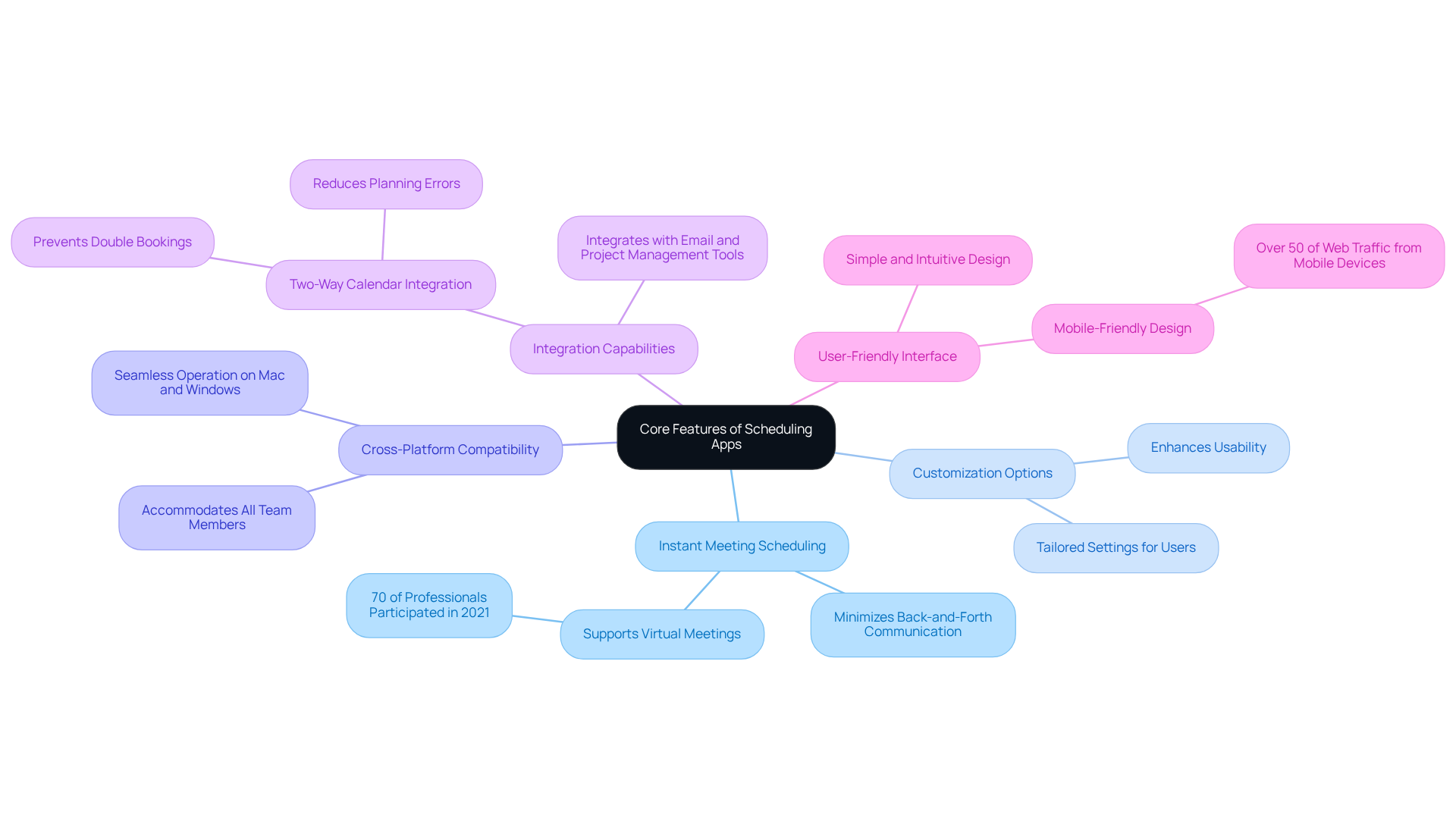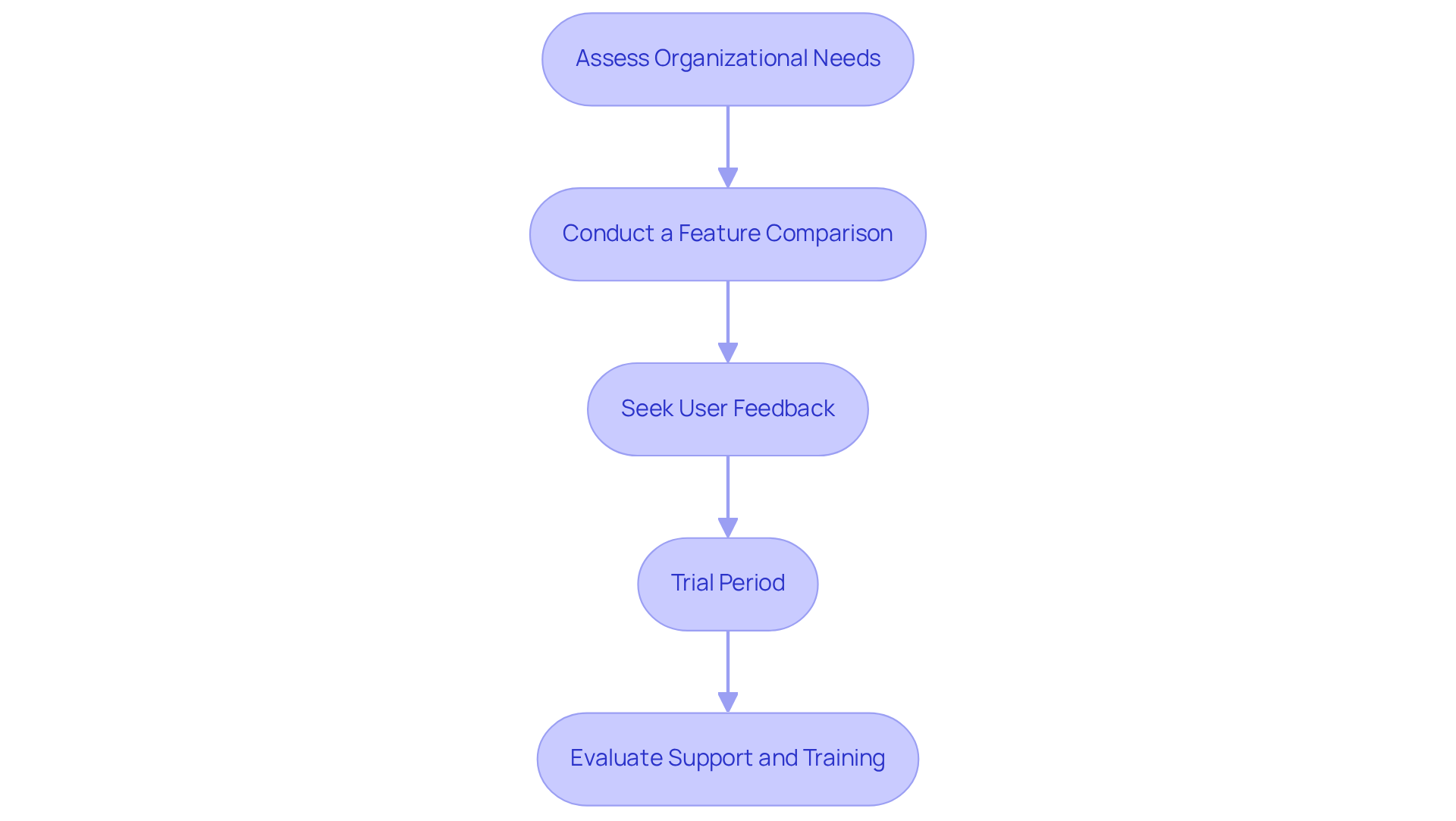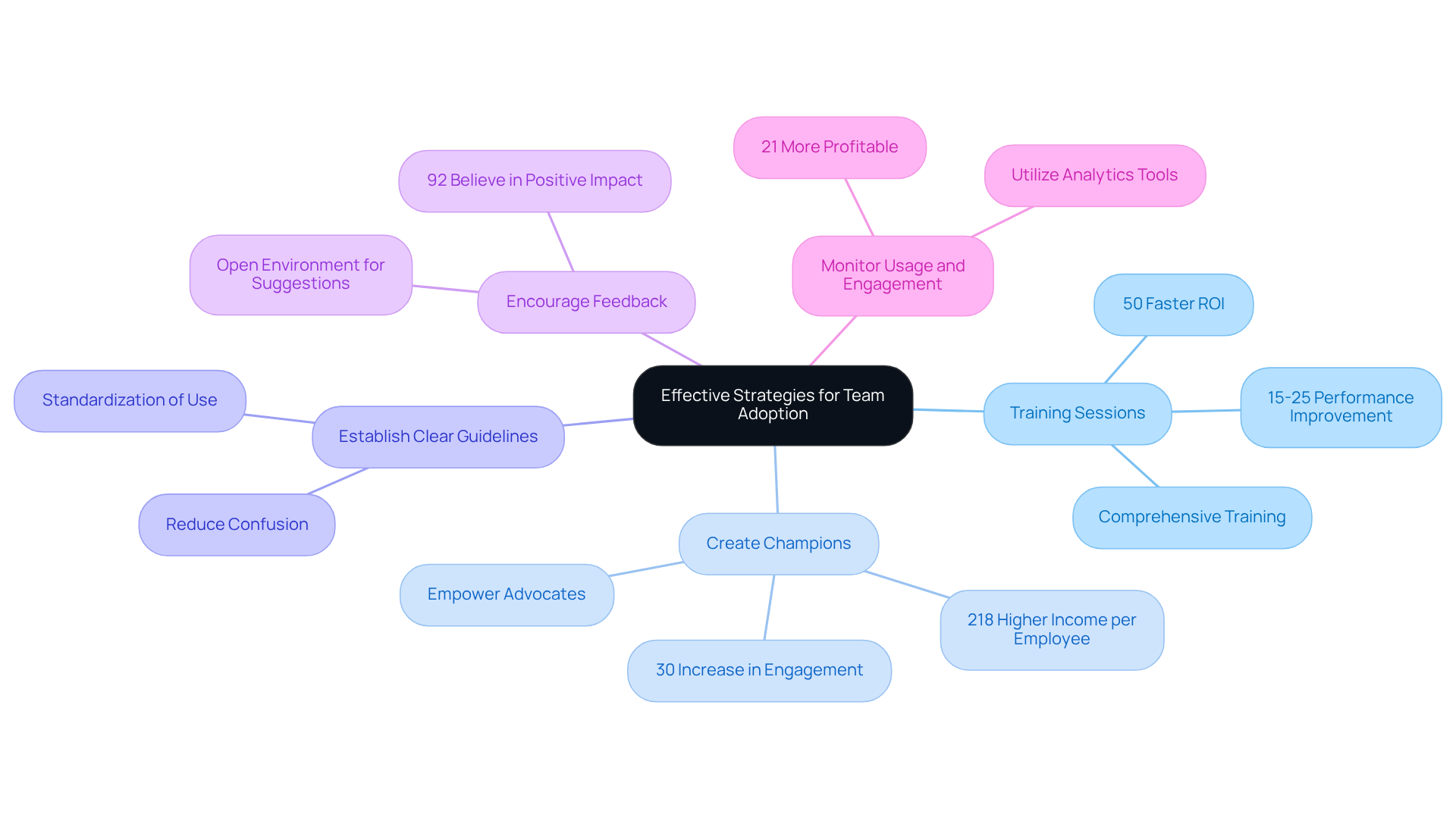4 Best Practices for Choosing an App for Coordinating Schedules

Overview
In today’s fast-paced environment, communication inefficiencies can severely hinder organizational productivity. Selecting the right app to coordinate schedules is crucial for overcoming these challenges. By assessing organizational needs, conducting thorough feature comparisons, seeking user feedback, and utilizing trial periods, organizations can make informed decisions that lead to enhanced operational efficiency.
Research shows that effective training and user engagement significantly boost productivity and satisfaction. When teams are equipped with the right tools, they can streamline scheduling processes, reducing time spent on coordination and increasing overall effectiveness. This not only fosters a more collaborative work environment but also empowers employees to focus on their core responsibilities.
To truly understand the impact of these practices, consider the unique features they offer. For instance, apps that allow for real-time updates and integrations with existing tools can transform how teams communicate and collaborate. By leveraging user feedback, organizations can continuously refine their approach, ensuring that the chosen solution meets evolving needs.
Ultimately, the right scheduling app can revolutionize how teams operate. By exploring these best practices, organizations can take decisive steps toward improving their scheduling processes. Don’t let communication inefficiencies hold your team back—invest in the right tools and watch productivity soar.
Introduction
Selecting the right app for coordinating schedules is crucial for enhancing organizational efficiency. Yet, many teams find themselves overwhelmed by the multitude of options available. Understanding the core features and functionalities of scheduling apps can empower organizations to streamline their planning processes and significantly boost productivity. With so many tools at their disposal, how can teams ensure they choose the most effective solution tailored to their unique needs?
Communication inefficiencies can lead to missed deadlines and decreased morale. In fact, studies show that poor scheduling can waste up to 30% of a team’s productive time. By leveraging the right scheduling app, organizations can not only mitigate these issues but also foster a more collaborative environment. The right tool can transform chaotic schedules into well-organized plans, enhancing overall team performance.
To achieve this, it’s essential to explore the unique features that different scheduling apps offer. Look for tools that provide:
- Intuitive interfaces
- Integration capabilities with existing systems
- Robust support for team collaboration
These features can make a significant difference in how effectively teams manage their time and resources.
In conclusion, the right scheduling app is not just a tool; it’s a strategic asset that can drive operational efficiency. Teams should take the time to evaluate their specific needs and explore the solutions available to them. By doing so, they can ensure they select a scheduling app that not only meets their requirements but also enhances their overall productivity.
Understand Core Features of Scheduling Apps
When selecting a planning application, understanding the essential features that can significantly impact your organization’s efficiency is vital. Communication inefficiencies can hinder productivity, making it crucial to choose the right tools. Consider these key functionalities:
-
Instant Meeting Scheduling: Seek apps that enable quick meeting setups, like Schedulelink. This feature minimizes the back-and-forth communication often associated with planning. In fact, according to Owl Labs, 70% of professionals participated in virtual meetings during 2021, underscoring the necessity of efficient scheduling tools in today’s work environment.
-
Customization Options: The ability to tailor settings for individual users or groups enhances usability, ensuring the app meets specific needs.
-
Cross-Platform Compatibility: Verify that the app operates seamlessly across various operating systems, such as Mac and Windows, to accommodate all team members.
-
Integration Capabilities: The app should integrate with other tools your organization relies on, like email and project management software, to streamline workflows. Two-way calendar integration is particularly crucial, as it helps prevent double bookings and reduces planning errors.
-
User-Friendly Interface: A simple, intuitive design facilitates quicker adoption and minimizes training time for employees. Moreover, with over 50% of global web traffic coming from mobile devices, a mobile-friendly design is essential for enhancing visitor experience.
By focusing on these features, organizations can select an app that not only meets their current needs but also supports future growth and flexibility in planning processes. It’s equally important to avoid common pitfalls, such as neglecting integration capabilities or overlooking user experience, which can undermine the effectiveness of the chosen app.

Choose the Right Scheduling App for Your Organization
Selecting the right app for coordinating schedules is crucial for overcoming communication inefficiencies that can hinder your organization’s productivity. A thorough assessment process tailored to your unique needs is essential. Here’s how to navigate this decision-making journey:
-
Assess Organizational Needs: Start by pinpointing the specific scheduling challenges your organization faces. Consider factors like group size, meeting frequency, and the tools currently in use. Understanding these elements lays the groundwork for a successful selection.
-
Conduct a Feature Comparison: Create a comparison chart that showcases the core features of potential apps. This visual tool will empower you to make informed decisions by clearly illustrating how each option aligns with your requirements.
-
Seek User Feedback: Involve your team in the selection process by gathering their insights on usability and desired functionalities. Engaging users not only fosters a sense of ownership but also leads to higher adoption rates and satisfaction with the chosen app.
-
Trial Period: Leverage free trials or demos to test the app in real-world scenarios. This hands-on experience will help you assess how well the app integrates into your daily tasks and meets your planning needs.
-
Evaluate Support and Training: Investigate the level of customer support and training resources provided by the app vendor. A responsive support team can significantly ease the transition, ensuring your staff can effectively utilize the new tool.
By following these steps, your organization can select an app for coordinating schedules that not only enhances operational efficiency but also aligns with your specific needs, ultimately driving productivity to new heights.

Implement Effective Strategies for Team Adoption
To ensure the successful adoption of the app for coordinating schedules, it’s crucial to tackle communication inefficiencies that can obstruct operational effectiveness. Consider the following strategies:
-
Training Sessions: Organize comprehensive training sessions tailored to different user levels. This ensures team members are well-acquainted with the app’s features and functionalities. Research indicates that effective training can lead to a 15-25% improvement in employee performance, enhancing overall engagement and retention. Moreover, companies with robust training initiatives experience a 50% faster return on investment from digital transformations, underscoring the importance of investing in training.
-
Create Champions: Identify and empower ‘champions’ within groups who can advocate for the app and assist their colleagues in navigating its features. Organizations that utilize champions often see a 30% increase in employee engagement, as these advocates foster a supportive environment for app adoption. Furthermore, companies with extensive workforce training report 218% higher income per employee, highlighting the financial benefits of creating champions.
-
Establish Clear Guidelines: Develop and communicate clear guidelines on how and when to use the app. This standardization helps reduce confusion and ensures that all group members are aligned in their usage practices of the app for coordinating schedules.
-
Encourage Feedback: Foster an open environment where group members can share their experiences and suggestions for enhancement. A feedback loop not only refines app usage but also addresses issues promptly, contributing to a culture of continuous improvement. Notably, 92% of employees believe well-designed training programs positively impact engagement, linking feedback mechanisms to enhanced employee satisfaction.
-
Monitor Usage and Engagement: Utilize analytics tools to track app usage and identify areas needing additional support. Frequent check-ins can assist in sustaining momentum and tackling challenges promptly, ensuring that the app remains a valuable resource for efficiency in planning. Organizations investing in employee development are 21% more profitable than their counterparts, providing a compelling reason to monitor usage and engagement.
By applying these approaches, you can significantly boost group adoption of the app for coordinating schedules, which will result in enhanced efficiency in planning and communication.

Continuously Optimize Scheduling Processes
To maintain and enhance the effectiveness of your scheduling processes, it’s essential to address communication inefficiencies head-on. Did you know that professionals waste an average of 91 minutes daily on unimportant tasks and meetings? This staggering statistic underscores the critical need for optimizing scheduling processes to boost productivity and efficiency.
Regular reviews should include scheduling periodic assessments of the app for coordinating schedules’ performance and its impact on team productivity. Evaluating whether it continues to meet organizational needs is crucial for sustained effectiveness. By regularly reviewing your processes, you can identify areas for improvement and ensure that your scheduling remains aligned with your strategic objectives.
-
Stay Updated on Features: Keeping abreast of updates and new features released by the app provider is essential. Utilizing these enhancements can significantly improve functionality and user experience, ultimately leading to higher satisfaction rates. As Brian Tracy wisely states, “Every minute spent in planning saves 10 minutes in execution,” emphasizing the value of staying informed about the tools at your disposal.
-
Solicit Ongoing Feedback: Continuously collect input from participants to identify pain points and areas for improvement. This proactive approach enables informed decisions about necessary adjustments, fostering a more user-centric environment. Neglecting user feedback can lead to missed opportunities for enhancement, so make it a priority to engage with your team regularly.
-
Benchmark Against Best Practices: Investigate industry best practices for planning and communication. Comparing your processes against these benchmarks can reveal potential areas for improvement, ensuring your organization remains competitive. Peter Drucker’s insights on time management stress the importance of effective planning and prioritization, which can guide your optimization efforts.
-
Adapt to Changes: Flexibility is key. Be open to adjusting your planning processes as organizational needs evolve. This may involve revisiting the app’s features or even considering new tools if necessary. Common pitfalls include failing to adapt to new features or ignoring user feedback, which can hinder optimization efforts.
By committing to continuous optimization, organizations can utilize an app for coordinating schedules to ensure their scheduling processes remain efficient, effective, and aligned with their strategic objectives. Explore the potential of your scheduling tools today and take the first step toward operational excellence.

Conclusion
Choosing the right scheduling app is crucial for organizations looking to boost productivity and enhance communication. Communication inefficiencies can significantly hinder operational effectiveness, making it essential to understand the core features that scheduling applications provide. Instant meeting scheduling, customization options, and integration capabilities are just a few aspects that can help organizations select tools that not only meet current needs but also support future growth. This strategic selection process is vital for overcoming barriers that impede efficiency.
Key insights from the article emphasize the importance of:
- Assessing organizational needs
- Conducting thorough feature comparisons
Actively involving team members in the selection process fosters a sense of ownership and ensures that the chosen app aligns with user requirements. Furthermore, implementing effective strategies for team adoption—such as training sessions and identifying champions within the organization—can significantly enhance the app’s utilization and overall satisfaction. Regularly reviewing and optimizing scheduling processes guarantees that the selected app continues to meet evolving demands, remaining a valuable resource for efficiency.
Ultimately, the significance of selecting and optimizing a scheduling app cannot be overstated. As organizations strive for operational excellence, embracing these best practices is essential for cultivating a culture of efficiency and collaboration. By taking decisive steps to choose the right tools and continually assess their effectiveness, organizations can unlock their full potential and elevate productivity to new heights.
Frequently Asked Questions
What are the essential features to look for in scheduling apps?
Key features to consider include instant meeting scheduling, customization options, cross-platform compatibility, integration capabilities, and a user-friendly interface.
Why is instant meeting scheduling important?
Instant meeting scheduling minimizes the back-and-forth communication often associated with planning, enhancing efficiency. It’s crucial in today’s work environment, where a significant number of professionals participate in virtual meetings.
How does customization enhance the usability of scheduling apps?
Customization allows settings to be tailored for individual users or groups, ensuring the app meets specific needs and improves overall usability.
What is cross-platform compatibility, and why is it important?
Cross-platform compatibility ensures that the app operates seamlessly across various operating systems, such as Mac and Windows, accommodating all team members and enhancing accessibility.
What role do integration capabilities play in scheduling apps?
Integration capabilities allow the app to connect with other tools, like email and project management software, streamlining workflows and preventing issues such as double bookings through two-way calendar integration.
Why is a user-friendly interface crucial in scheduling apps?
A simple, intuitive design facilitates quicker adoption and reduces training time for employees. Additionally, with a large portion of web traffic coming from mobile devices, a mobile-friendly design enhances the user experience.
What common pitfalls should organizations avoid when selecting scheduling apps?
Organizations should avoid neglecting integration capabilities and overlooking user experience, as these factors can undermine the effectiveness of the chosen app.
